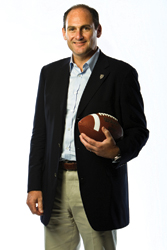 |
ICON SMI
Pac-10 Commissioner Larry Scott. |
Larry Scott was 7 years old when his father would take him to Woodbury Country Club on Long Island and throw tennis balls to him.
Forget about the net, his father would say. He wanted young Larry to swing hard enough to hit the balls over the 12-foot-tall fence that surrounded the tennis court.
Scott’s been trying to do that ever since.
“Larry’s the kind of guy that swings for the fences,” said his friend of 20 years, Jeff Hunt, an Austin, Texas, public relations and brand consultant. “He takes the view that, nothing ventured, nothing gained. He doesn’t always hit home runs, but he’s done pretty well.”
Scott always has been and still is a tennis guy. He played in college and professionally before spending nearly 20 years as an executive with the ATP and WTA. But it didn’t take him long to learn his way around the college game.
In two years as commissioner of the Pac-10 Conference, which officially becomes the Pac-12 on Friday, Scott has expanded the league with the addition of Colorado and Utah, negotiated a record media contract, created a football championship game and set the groundwork for a conference channel.
In short, the Pac-10 has gone from a West Coast afterthought to one of the most progressive college conferences in the country under his guidance.
The conference’s record 12-year, $3 billion media contract with ESPN and Fox was the byproduct — but not the culmination — of a two-year plan that Scott put in place in 2009 when he was hired from the WTA. The deal will transform the Pac-12 from one of the poorest revenue-producing leagues among the six major conferences to one of the best.
And with it have come accolades from those inside the conference and out who thought the Pac-10 couldn’t command that kind of money because it largely lacked relevance on the national scene.
“The conference in the past was what I’d call sleepy and procedural. He’s made it entrepreneurial and creative,” said Michael Crow, president at Arizona State University and chairman of the conference’s Presidents Council. “It’s been a challenge, but he has us working as a group instead of individual universities. It’s a political process and he’s been very successful at it.”
■ ■ ■ ■
It wasn’t long before Scott was sending the tennis balls over that 12-foot-tall fence. Every time he did, his father rewarded him with an ice cream cone.
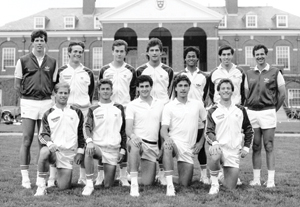 |
HARVARD UNIVERSITY
Scott (front row center) was an All-America tennis player in his time at Harvard. |
“I liked my ice cream,” said Scott, 46, whose father was a New York City attorney and mother was an office manager for a doctor.
By the time he was 12, Scott was nationally ranked on the junior tennis circuit, and he rose to No. 9 in the country when he was 16. He went on to win the New York state high school championship and play for Harvard, where he studied European history and was an NCAA All-American.
Scott played an aggressive style, taking advantage of his lanky 6-foot-2 frame to blister serves at his opponents and then rush the net.
“I liked to force the play,” he said.
Scott lasted a few years in professional tennis and actually won a first-round match at Wimbledon against Greg Holmes. His lone victory on the ATP circuit came in 1987 when he teamed with Dan Goldie to win the doubles title at Newport, R.I., another event with a fast-grass surface that favored to his attacking style.
But after losing 17 of 18 singles matches, it became clear to Scott that it was time to use his other skills in an administrative role with the ATP, where he rose to COO. He eventually moved over to the WTA as CEO, where he convinced the Grand Slam events to pay their men’s and women’s champions the same, and negotiated a six-year, $88 million deal with Sony Ericsson to title sponsor the women’s tour.
After 20 years in the tennis business, Scott found himself in talks with Spencer Stuart, the executive search firm that was seeking both a CEO for the ATP and a commissioner for the Pac-10. Scott’s big idea in tennis was to combine the ATP and WTA, but when those talks broke down, Jed Hughes of Spencer Stuart famously said to Scott: There’s another job that you’d be perfect for.
Scott played tennis at Harvard, but he was hardly familiar with the business of intercollegiate athletics. When he called Hunt, his longtime buddy in Austin, Scott said, “Have you ever heard of the Pac-10?”
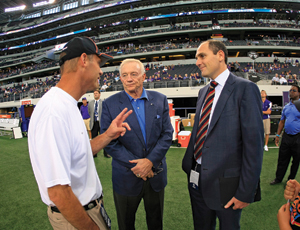 |
ICON SMI
Scott (Above with Oregon State football coach Mike Riley and Jerry Jones, and below with Arlen Kantarian) brought an entrepreneurial spirit from tennis to college athletics. |
It’s not that Scott had never heard of the conference before, but it did speak to where it stood in relation to the nation’s marquee leagues like the Big Ten and SEC. And he knew that his friend would have never envisioned him leaving the tennis world for a gig as a conference commissioner.
“Larry was assigned to give us maximum projection of Pac-12 sports and he came in with the business acumen to do that,” Crow said. “Very few people have the package that Larry brought, in terms of being a student athlete at Harvard, majoring in history, understanding the commitment of the college athlete and having played and worked in professional sports.”
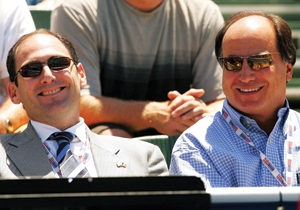 |
GETTY IMAGES
|
Scott, a husband and father of three children who had grown weary of the international travel required in tennis, took a leap of faith into the Pac-10, and the conference took it with him.
“He had done a lot of things in tennis that we thought translated well to our space,” said Bob Bowlsby, the Stanford athletic director who chaired the conference’s search for a new commissioner. “At the WTA, he took a bunch of tournaments around the world with their own boards and marketing people and built them into a business entity. That’s what we needed to happen in the Pac-10, to get all of the institutions on the same page.”
■ ■ ■ ■
While expansion, divisional alignment and a football championship dominated the headlines last year, there were two less-sexy issues that Scott focused on before entering media negotiations earlier this year.
One, he had to persuade the schools to share revenue equally. Southern California and UCLA traditionally had earned more revenue than their conference brethren because they were in the Los Angeles market and appeared on national TV more often.
Two, he had to talk the schools into turning over their media rights to the conference for at least 10 years. With control of media rights from each school, Scott was sure he could negotiate a better media contract with the national networks and forge ahead with his goal of creating a conference channel.
With both moves, which were executed over a three-month period last fall, he was coming to the net, trying to force the action, but he found that getting all of the schools on the same page would take every bit of his persuasive powers.
In meetings and conference calls with ADs and university presidents last fall, Scott came up with a plan: Equal revenue sharing would kick in only if the Pac-10 got $170 million or more a year for its TV rights. If it came out to less, the schools on TV, typically USC and UCLA, would continue to make more than the others for two more years.
As part of a strategic move, he also put the issue of divisional alignment on the table in the same meetings, believing that concessions in one area might lead to a deal in another. It was a subtle tactic that proved to be genius.
It was imperative for USC and UCLA to maintain their annual games against their rivals from the northern part of the state, Stanford and California, but once the league decided to split into north and south divisions, it became clear that USC and UCLA would be in the south and Cal and Stanford would be in the north.
Scott conceded that USC and UCLA would continue to play Cal and Stanford each season as permanent nondivision foes, if USC and UCLA would agree to share revenue equally.
“There was a lot of quid pro quo for the California schools,” Scott said. “We had to find trade-offs and common ground.”
The commissioner also pointed to the bigger schools in other conferences that already share revenue equally. What about Ohio State in the Big Ten and Florida in the SEC? How are USC and UCLA any different?
“There were certainly heated discussions around it,” Scott said. “Any time you talk about dividing the pie, those are the toughest conversations. No one was ignoring the fact that USC and UCLA could make more money, but if you look at the healthiest conferences, they’re sharing equally. The conference can only be healthy if the members have a certain level of health.”
USC Athletic Director Pat Haden said he and UCLA Athletic Director Dan Guerrero spent many late nights on the phone over those three months last fall. Their presidents ultimately made the decision, but Haden and Guerrero advised them to go with the equal-sharing model in hopes that it would produce more media revenue down the road.
They just didn’t know that the extra revenue would come so abundantly in the form of a deal with ESPN and Fox that will average $250 million a year, well above the $170 million that was initially benchmarked. The conference’s previous media contract paid just $54 million a year.
“What you’re seeing is unprecedented leadership from Larry,” said Chris Bevilacqua, the media consultant who worked with Scott the past two years to forge the new deal and establish a model for the conference channel. “He got them to consolidate at the center rather than sell from different angles, which is a value killer. He basically said, ‘Trust me,’ and they did.”
■ ■ ■ ■
Knowing that he needed to convince the Pac-10’s schools to operate differently, Scott spent much of his first year traveling from campus to campus on diplomacy missions with the ADs and presidents. He wanted to do more than work for them, he wanted to get to know them individually so he could anticipate how they would react in certain situations.
He had learned how to navigate political minefields from his days in the fragmented tennis world, where tournaments and players wanted autonomy.
“With so many varied stakeholder groups [in tennis], the only way to be successful long term was to be an effective consensus-driven and diplomatic leader,” said Scott, who also learned at the feet of ATP executives Hamilton Jordan and Mark Miles, both of whom came from political backgrounds and used that expertise effectively governing the ATP.
At the Pac-10, Scott also consulted with pros like Bevilacqua and Hunt, as well as other influential figures with conference ties. Among them were Nike founder and Oregon benefactor Phil Knight; former News Corp. COO Peter Chernin, a Cal graduate; Apple retail chief Ron Johnson, a Stanford alumnus; and Google chief legal officer David Drummond, a Stanford law graduate. Scott has engaged each of them in discussions about the conference’s media enterprise, which will encompass the conference’s TV channel, digital channel and properties division.
To make sure he had time to get away from the office, Scott structured a staff so that he wouldn’t get bogged down in the traditional duties of a commissioner. One of his first moves was to hire Kevin Weiberg, the former Big 12 commissioner and Big Ten Network executive. Weiberg handles much of the day-to-day duties, such as compliance and academic issues, “while Larry is out making deals,” Bowlsby said.
Scott then brought in Danette Leighton from the NBA as the conference’s chief marketer. The Arizona graduate had run marketing for the Sacramento Kings and Arco Arena before joining the conference as its first CMO.
“Even though a lot of what Larry has done might be considered nontraditional, he’s never just shooting from the hip,” Bevilacqua said. “He studies issues, he studies people, he drives consensus. With everything that has happened, I’ve never once seen him lose his temper. He just doesn’t get mad.”
Scott said in those meetings with ADs and presidents last fall that his strategy was to “keep it factual. That takes the emotion out of it.”
And when there was “an elephant in the room, put it on the table and find a solution.”
During negotiations with ESPN and Fox, the conference agreed to grant the networks eight football games a year on Thursday or Friday nights. Scott knew it would be unpopular with administrators and coaches, who rarely were asked to play non-Saturday games in the Pac-10.
“That was a real hardship for some schools, whether it was because of midweek traffic, parking, holidays, whatever, but every school had to take on some burden if we’re going to be one for all and all for one,” Scott said. “That was part of getting a significantly improved TV contract. I just tried to be honest and admit that there are things you aren’t going to love about it, but here’s what you will love about it.”
For Haden, who winces at the notion of Thursday home games starting in the middle of Los Angeles’ rush-hour traffic, playing non-Saturday games was admittedly a tough concession.
“Larry sold us on a vision of where he was trying to get when a lot of people in the room didn’t think we could possibly get there,” Haden said. “You’ve heard the old ‘herding cats’ analogy about dealing with 12 different schools, but Larry is able to rally themes so that all 12 schools jump in line. It’s just good leadership.”
■ ■ ■ ■
It was a little more than a year ago that Scott sat on the patio of his friend’s home in Austin, sipping wine and smoking a cigar. He had just spent the day with University of Texas President Bill Powers, AD DeLoss Dodds and women’s AD Chris Plonsky discussing the merits of a Pac-16 that would include the Longhorns.
“We weren’t celebrating yet, but we were feeling pretty damn good,” said Hunt, Scott’s friend who assisted with the bid to lure Texas. “We thought there was going to be an announcement the next day.”
The next morning, Powers called Scott and told him that Texas would be staying in the Big 12. Scott had swung for the fences and, this time, missed.
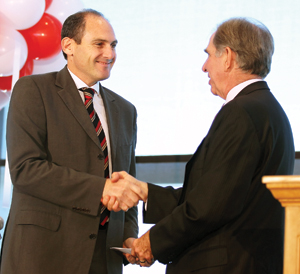 |
GETTY IMAGES
Scott welcomed Utah President Michael Young to the conference last June. |
The conference settled for Colorado and Utah and got the football championship game Scott wanted.
In the aftermath, other conference commissioners lauded the Big 12 and Texas for holding things together. It was for the “greater good” of intercollegiate athletics, many of them said.
What they meant was that Scott nearly threw a tsunami on the college landscape, and who knows what it might look like today had he succeeded. It had them scared to death.
“We knew it was a bold move and we knew we were sticking our necks out there,” Scott said. “I went into it with my eyes wide open. But I’m also very clear on my mandate and who I’m working for. … There is a level of collegiality in college sports that’s good, but at the end of the day schools and conferences are competitors.
“The fact that some people thought it wasn’t in the best interests of college sports, well, I took that to be a little self-serving.”
Scott has enough on his plate now that another bid for a 16-team conference probably won’t happen for a while. He is in the process of negotiating with potential partners on a conference channel. He and his staff are preparing for the league’s first football championship game. And he remains committed to building the Pac-12’s brand throughout Asia, in part, by making the conference channel available overseas.
Scott’s vision doesn’t end with athletics. He invited the provosts from each school to the most recent conference meetings, something that had never happened before. They discussed ways in which they could buy in bulk, whether it was books for the library or technology to go in classrooms as well as football stadiums. Each school has vendors that it works with, but imagine if they could combine their buying power, Scott said.
It’s the kind of thing that has Scott swinging for the fences again.
“We’re in the early stages of redefining what a college conference can be,” he said. “It’s just a question of where your imagination can take you when you have 12 institutions. I hope we look back in five or 10 years and say, ‘The Pac-12 has redefined what a college conference can be.’”






